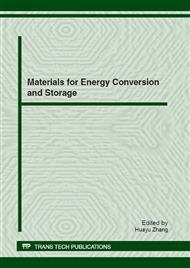[1]
M. Gratzel, Conversion of sunlight to electric power by nanocrystalline dye-sensitized solar cells, J. Photochem. Photobiol. A. 164 (2004) 3-14.
DOI: 10.1016/j.jphotochem.2004.08.014
Google Scholar
[2]
K. Hara, T. Horiguchi, T. Kinoshita, et al., Highly efficient photon-to-electron conversion with mercurochrome-sensitized nanoporous oxide semiconductor solar cells, Sol. Energy Mater. Sol. Cells. 64 (2000) 115-134.
DOI: 10.1016/s0927-0248(00)00065-9
Google Scholar
[3]
K. Kakiuchi, E. Hosono, S. Fujihara, Enhanced photoelectrochemical performance of ZnO electrodes sensitized with N-719, J. Photochem. Photobiol. A. 179 (2006) 81-86.
DOI: 10.1016/j.jphotochem.2005.07.018
Google Scholar
[4]
B.D. Yuhas, P. Yang, Nanowire-based all-oxide solar cells, J. Am. Chem. Soc. 131 (2009) 3756-3761.
DOI: 10.1021/ja8095575
Google Scholar
[5]
A.R. Rao, V. Dutta, Achievement of 4.7% conversion efficiency in ZnO dye-sensitized solar cells fabricated by spray deposition using hydrothermally synthesized nanoparticles, Nanotechnology 19 (2008) 445712.
DOI: 10.1088/0957-4484/19/44/445712
Google Scholar
[6]
S. Chappel, A. Zaban, Nanoporous SnO2 electrodes for dye-sensitized solar cells: improved cell performance by the synthesis of 18nm SnO2 colloids, Sol. Energy Mater. Sol. Cells 71 (2002) 141-152.
DOI: 10.1016/s0927-0248(01)00050-2
Google Scholar
[7]
A. Kay, M. Gratzel, Dye-sensitized core-shell nanocrystals: improved efficiency of mesoporous tin oxide electrodes coated with a thin layer of an insulating oxide, Chem. Mater. 14 (2002) 2930-2935.
DOI: 10.1021/cm0115968
Google Scholar
[8]
A. Hagfeldt, M. Graetzel, Light-induced redox reactions in nanocrystalline systems, Chem. Rev. 95 (1995) 49-68.
DOI: 10.1021/cr00033a003
Google Scholar
[9]
S. Rani, P. Suri, P.K. Shishodia, R.M. Mehra, Synthesis of nanocrystalline ZnO powder via sol-gel route for dye-sensitized solar cells, Sol. Energy Mater. Sol. Cells. 92 (2008) 1639-1645.
DOI: 10.1016/j.solmat.2008.07.015
Google Scholar
[10]
A.B. Moghaddam, T. Nazari, J. Badraghi, et al., Synthesis of ZnO nanoparticles and electrodeposi- tion of polypyrrole/ZnO nanocomposite film, Int. J. Electrochem. Sci. 4 (2009) 247-257.
Google Scholar
[11]
A.Y. El-Etre, S.M. Reda, Characterization of nanocrystalline SnO2 thin film fabricated by electro- deposition method for dye-sensitized solar cell application, Appl. Surf. Sci. 256 (2010) 6601-6606.
DOI: 10.1016/j.apsusc.2010.04.055
Google Scholar
[12]
J. Zhang, L. Gao, Synthesis and characterization of nanocrystalline tin oxide by sol-gel method, J. Solid State Chem. 177 (2004) 1425-1430.
DOI: 10.1016/j.jssc.2003.11.024
Google Scholar
[13]
Z. Chen, J.K.L. Lai, C.H. Shek, H. Chen, Synthesis and structural characterization of rutile SnO2 nanocrystals, J. Mater. Res. 18 (2003) 1289-1292.
DOI: 10.1557/jmr.2003.0176
Google Scholar
[14]
A. Gamard, O. Babot, B. Jousseaume, M.C. Rascle, T. Toupance, G. Campet, Conductive F-doped tin dioxide sol-gel materials from fluorinated β-diketonate tin(IV) complexes. characterization and thermolytic behavior, Chem. Mater. 12 (2000) 3419-3426.
DOI: 10.1021/cm001073k
Google Scholar
[15]
H. Zhang, Z.T. An, F. Li, Q. Tang, K. Lu, W.C. Li, Synthesis and characterization of mesoporous c-ZrO2 microspheres consisting of peanut-like nano-grains, J. Alloys Compd. 464 (2008) 569-574.
DOI: 10.1016/j.jallcom.2007.10.039
Google Scholar


